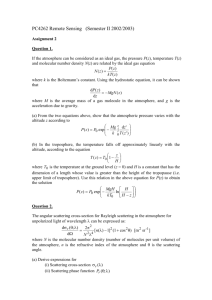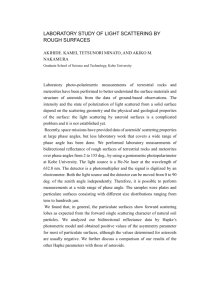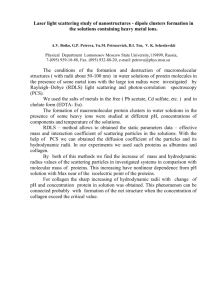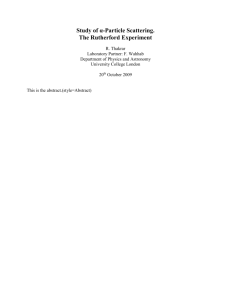template
advertisement
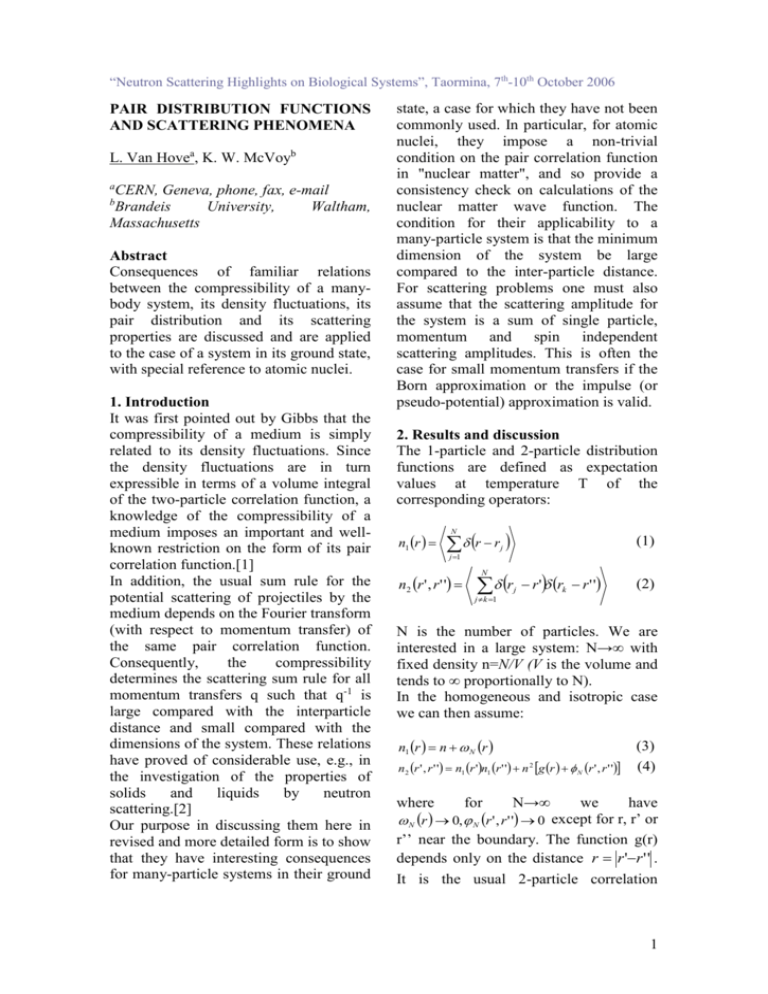
“Neutron Scattering Highlights on Biological Systems”, Taormina, 7th-10th October 2006 PAIR DISTRIBUTION FUNCTIONS AND SCATTERING PHENOMENA L. Van Hovea, K. W. McVoyb a CERN, Geneva, phone, fax, e-mail Brandeis University, Waltham, Massachusetts b Abstract Consequences of familiar relations between the compressibility of a manybody system, its density fluctuations, its pair distribution and its scattering properties are discussed and are applied to the case of a system in its ground state, with special reference to atomic nuclei. 1. Introduction It was first pointed out by Gibbs that the compressibility of a medium is simply related to its density fluctuations. Since the density fluctuations are in turn expressible in terms of a volume integral of the two-particle correlation function, a knowledge of the compressibility of a medium imposes an important and wellknown restriction on the form of its pair correlation function.[1] In addition, the usual sum rule for the potential scattering of projectiles by the medium depends on the Fourier transform (with respect to momentum transfer) of the same pair correlation function. Consequently, the compressibility determines the scattering sum rule for all momentum transfers q such that q-1 is large compared with the interparticle distance and small compared with the dimensions of the system. These relations have proved of considerable use, e.g., in the investigation of the properties of solids and liquids by neutron scattering.[2] Our purpose in discussing them here in revised and more detailed form is to show that they have interesting consequences for many-particle systems in their ground state, a case for which they have not been commonly used. In particular, for atomic nuclei, they impose a non-trivial condition on the pair correlation function in "nuclear matter", and so provide a consistency check on calculations of the nuclear matter wave function. The condition for their applicability to a many-particle system is that the minimum dimension of the system be large compared to the inter-particle distance. For scattering problems one must also assume that the scattering amplitude for the system is a sum of single particle, momentum and spin independent scattering amplitudes. This is often the case for small momentum transfers if the Born approximation or the impulse (or pseudo-potential) approximation is valid. 2. Results and discussion The 1-particle and 2-particle distribution functions are defined as expectation values at temperature T of the corresponding operators: n1 r r r N n2 r ' , r ' ' (1) j j 1 r N j k 1 j r ' rk r ' ' (2) N is the number of particles. We are interested in a large system: N→∞ with fixed density n=N/V (V is the volume and tends to ∞ proportionally to N). In the homogeneous and isotropic case we can then assume: n1 r n N r n2 r ' , r ' ' n1 r 'n1 r ' ' n 2 g r N r ' , r ' ' (3) (4) where for N→∞ we have N r 0, N r ' , r ' ' 0 except for r, r’ or r’’ near the boundary. The function g(r) depends only on the distance r r 'r ' ' . It is the usual 2-particle correlation 1 function which, if we exclude the case of long range order, goes to zero for r beyond a certain finite range ro. If the system is large, the form factor F(q) represents the elastic scattering corresponding to the terms n1=n2. Sin(q), which for a large system represents the inelastic scattering, contains a part sin(q) independent of the size V of the system and a size-dependent term S inN Q . S inN Q tends to zero for q→0. The system being large, for these values of q the whole inelastic scattering is given by the sizeindependent term sin(q). It tends to 1 (quasi-elastic scattering) for q>> n1 3 and The proof has been given elsewhere.[2] For a system with hard core radius rc this inequality becomes 3 g r dr n (1 / 3) rc 4 rc (6) and can be an useful information source for approximate determinations of the pair correlation in nuclear matter. to sin 0 1 4n g r r 2 dr for q<< r01 0 (in practice the range r0 of g(r) is usually of order n 1 / 3 ). The latter limit is given by the thermodynamic density fluctuation. If, on the contrary, we let q tend to zero at the same time as we let the system become very large, the sizedependent part S inN Q of the inelastic scattering must be taken into account. It is obvious that it contributes when q-1 is of the same order V(1/3) as the range of N r ' , r ' ' . When q=0 its contribution is sin(0) and exactly compensates the sizeindependent term. The behaviour of Sin(q) for a large system at general temperature is illustrated in Figure 1. Consideration of the density fluctuations leads to an equality involving the integral g r r 2 Explicit calculation in special cases shows that the integral I can have either sign: it is positive for a perfect Bose gas and negative for a perfect Fermi gas. dr . It is worth noting that by 0 using the property of the scattering function S(q) to be positive one can derive the inequality 3 I g r dr n (1 / 3) 4 0 2 Figure 1 The inelastic part of the scattering function Sin(q) as function of q for positive temperature (a), ground state (b) and elastic part of the scattering function (c) (5) Acknowledgments The organisers gratefully acknowledge all the participants. References 1) J. de Boer, Reports on Progress of Physics, 12, 305 (1948). 2) G. Placzek, B.R.A. Nijboer, L. Van Hove, Phys. Rev. 82, 392 (1951).




